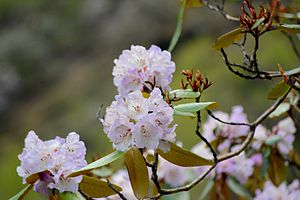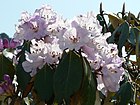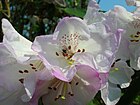Note: This is a project under development. The articles on this wiki are just being initiated and broadly incomplete. You can Help creating new pages.
Rhododendron campanulatum
Rhododendron campanulatum is an evergreen shrub. It can grow up to 4.5 metres tall. Some plants in cultivation in western Scotland have attained a height of more than 9 metres with a bole 40cm in diameter. The plant is harvested from the wild for local use as a medicine and source of materials. It is often grown as an ornamental.
Contents
- 1 Uses
- 2 Parts Used
- 3 Chemical Composition
- 4 Common names
- 5 Properties
- 6 Habit
- 7 Identification
- 8 List of Ayurvedic medicine in which the herb is used
- 9 Where to get the saplings
- 10 Mode of Propagation
- 11 How to plant/cultivate
- 12 Commonly seen growing in areas
- 13 Photo Gallery
- 14 References
- 15 External Links
Uses
Colds, Headaches, Chronic rheumatism, Sciatica, Syphilis, Phthisis, Chronic fevers.[1]
Parts Used
Chemical Composition
It contains The phytochemical studies showed the presence of terpenoids in the petroleum and methanol extracts, steroids in the diethyl ether and chloroform extracts, tannins in the diethyl ether and methanol extracts, and glycosides, flavonoids, and saponins in the methanol extract.[2]
Common names
| Language | Common name |
|---|---|
| Kannada | |
| Hindi | Burans, Semru |
| Malayalam | |
| Tamil | |
| Telugu | |
| Marathi | |
| Gujarathi | |
| Punjabi | |
| Kashmiri | |
| Sanskrit | |
| English | Bell Rhododendron |
Properties
Reference: Dravya - Substance, Rasa - Taste, Guna - Qualities, Veerya - Potency, Vipaka - Post-digesion effect, Karma - Pharmacological activity, Prabhava - Therepeutics.
Dravya
Rasa
Guna
Veerya
Vipaka
Karma
Prabhava
Habit
Identification
Leaf
| Kind | Shape | Feature |
|---|---|---|
Flower
| Type | Size | Color and composition | Stamen | More information |
|---|---|---|---|---|
| {{{5}}} |
Fruit
| Type | Size | Mass | Appearance | Seeds | More information |
|---|---|---|---|---|---|
Other features
List of Ayurvedic medicine in which the herb is used
Where to get the saplings
Mode of Propagation
Seeds, Cuttings of half-ripe wood, Air layering.
How to plant/cultivate
Rhododendron campanulatum is native to higher elevations in the Himalayas, where it can be found at elevations up to 4,400 metres.[5]
Commonly seen growing in areas
Open slopes in the alpine zone, Rhododendron thickets, Forests, Mountain slopes.
Photo Gallery
References
- ↑ Indian Medicinal Plants by C.P.Khare
- ↑ Chemistry
- ↑ Local names
- ↑ [Morphology"]
- ↑ Cultivation
External Links
- Ayurvedic Herbs known to be helpful to treat Colds
- Ayurvedic Herbs known to be helpful to treat Headaches
- Ayurvedic Herbs known to be helpful to treat Chronic rheumatism
- Ayurvedic Herbs known to be helpful to treat Sciatica
- Ayurvedic Herbs known to be helpful to treat Syphilis
- Ayurvedic Herbs known to be helpful to treat Phthisis
- Ayurvedic Herbs known to be helpful to treat Chronic fevers
- Herbs with Leaves used in medicine
- Herbs with Dried twigs used in medicine
- Herbs with common name in Hindi
- Herbs with common name in English
- Habit - Evergreen shrub
- Index of Plants which can be propagated by Seeds
- Index of Plants which can be propagated by Cuttings of half-ripe wood
- Index of Plants which can be propagated by Air layering
- Herbs that are commonly seen in the region of Open slopes in the alpine zone
- Herbs that are commonly seen in the region of Rhododendron thickets
- Herbs that are commonly seen in the region of Forests
- Herbs that are commonly seen in the region of Mountain slopes
- Herbs






